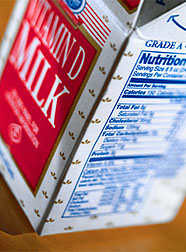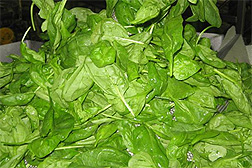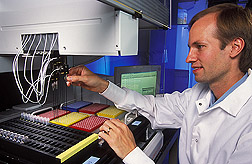This page has been archived and is being provided for reference purposes only. The page is no longer being updated, and therefore, links on the page may be invalid.
| July 2010 |
Baby's Obesity Risk: What's Mom's Influence?Whether a woman is lean or overweight during her pregnancy may influence the likelihood of her child becoming an overweight or obese adult, Agricultural Research Service (ARS)-funded research with laboratory rats suggests. The child's body-weight-regulating mechanisms might be permanently altered by maternal signals associated with the mother's own overweight. All of the baby rats in the study were of normal weight at birth and at weaning. However, when the weaned offspring were given free access to an unlimited amount of high-fat rations, the offspring of overweight dams showed remarkable sensitivity to the high-fat rations. They gained significantly more weight, and more of that weight as fat mass, than did the offspring of lean dams. This is a follow-up to a preliminary study published several years ago in American Journal of Physiology-Regulatory, Integrative and Comparative Physiology. Scientific contact: Kartik Shankar, (501) 364-2847, ARS Arkansas Children's Nutrition Center, Little Rock, Ark. |
|
|
|
Less is More When Restraining Calories Boosts ImmunityScientists funded by the Agricultural Research Service (ARS) found that volunteers who followed a low-calorie diet or a very-low-calorie diet not only lost weight, but also significantly enhanced their immune response. In the study, 46 overweight (but not obese) men and women aged 20 to 40 years were required to consume either a 30-percent or 10-percent calorie-restricted diet for six months. Delayed-type hypersensitivity skin tests and T-cell proliferative responses were significantly increased in both calorie-restrained groups. These results show for the first time that short-term calorie restriction for six months in humans improves the function of T-cells. Scientific contact: Simin N. Meydani, (617) 556-3129, Jean Mayer USDA Human Nutrition Research Center on Aging, Boston, Mass. |
Tracing Listeria monocytogenes in a Commercial Chicken Cooking PlantIncoming raw poultry is the primary source of Listeria monocytogenes contamination in commercial chicken cooking plants, according to a 21-month study conducted by Agricultural Research Service (ARS) scientists and their collaborators at the University of Georgia. By testing a brand-new commercial cooking facility before and after processing began, the research team was able to track sources of contamination. The study's results will help these facilities more sharply focus their sanitation processes to reduce cross-contamination. Scientific contact: Mark E. Berrang, (706) 546-3551, ARS Bacterial Epidemiology and Antimicrobial Resistance Unit, Richard B. Russell Research Center, Athens, Ga. |
|
|
|
Vitamin D and Calcium Interplay ExploredIncreasing calcium intake is a common—yet not always successful—strategy for reducing bone fractures. But a study supported in part by the Agricultural Research Service (ARS) underscores the importance of vitamin D and its ability to help the body utilize calcium. The study also may explain why increasing calcium alone isn't always successful in dealing with this problem. The results support the idea that correcting inadequate blood levels of vitamin D is more important than increasing dietary calcium intake beyond 566 milligrams (mg) a day among women and 626 mg a day among men for better bone mineral density. Scientific contact: Bess Dawson-Hughes, (617) 556-3064, Bone Metabolism Laboratory, Jean Mayer USDA Human Nutrition Research Center on Aging, Boston, Mass. |
Nutrient Retention of Safer Salads ExploredAgricultural Research Service (ARS) scientists and colleagues have looked into the effect of various levels of irradiation on concentrations of four vitamins and four carotenoids in two popular baby-leaf spinach cultivars. Irradiating salad leaves after washing is used to reduce the amount of harmful and non-harmful microorganisms. Following irradiation, leaf tissues were tested for concentrations of vitamins C, E, K and folate (sometimes called vitamin B9) and the four carotenoids lutein/zeaxanthin, neoxanthin, violaxanthin and beta-carotene. Four nutrients-folate, E, K and neoxanthin-exhibited little or no change in concentration with increasing levels of irradiation. Levels of lutein/zeaxanthin and B-carotene were reduced on average by 12 percent at the 2.0 kiloGrays level, which is within the range of natural variation. Scientific contact: Gene E. Lester, (956) 447-6322, ARS Crop Quality and Fruit Insects Research Unit, Kika de la Garza Subtropical Agricultural Research Center, Weslaco, Texas. |
|
|
|
Broiler Carcass Cleansing Solution Removes Harmful BacteriaUsing a cleansing solution to wash eviscerated chicken carcasses was effective in removing bacteria that cause human foodborne diseases, according to a study by Agricultural Research Service (ARS) scientists. In the first set of studies, carcasses were spray-washed with different concentrations of the lauric acid-potassium hydroxide combination. Results showed that increasing the concentration of lauric acid to 2 percent and potassium hydroxide to 1 percent of the solution generally removed more bacteria from the broiler carcass. In another series of studies, it was found that spray pressure did not have a significant effect on reducing bacterial contamination. But increasing the amount of time the carcasses were sprayed from 5 to 15 or 30 seconds resulted in significantly reduced bacterial contamination. Scientific contact: Arthur Hinton, (706) 546-3621, ARS Poultry Processing and Swine Physiology Research Unit, Richard B. Russell Research Center, Athens, Ga. |
Cutting Fat-and Calories-from Cakes and FrostingsAn Agricultural Research Service (ARS) researcher is formulating low-fat cake mixes and frostings with Fantesk-microdroplets of trans-fat-free cooking oil, encapsulated in cornstarch or wheat flour. Fantesk was developed in the 1990s by ARS chemists. Experiments have shown that, when making a cake with a mix that contains Fantesk, cooking oil doesn't have to be added. The mixes containing Fantesk produce low-fat cakes that have better texture and a higher volume. What's more, the lower-fat frostings with Fantesk have the smooth texture and spreadability of buttercream favorites, yet contain up to 50 percent less fat. Scientific contact: Mukti Singh, (309) 681-6357, ARS Functional Foods Research Unit, National Center for Agricultural Utilization Research, Peoria, Ill. |
|
|
|
A New Approach that Saves Eyesight and Lives in the Developing WorldTwo Agricultural Research Service (ARS) scientists are part of an international team that has found a way to boost the nutritional value of corn. This has the potential to reduce the number of children in developing countries who lose their eyesight, become ill or die each year because of vitamin A deficiencies. The researchers helped identify genetic sequences linked to higher beta-carotene levels in corn and demonstrated an inexpensive and fast way to identify corn plants that will produce even higher levels. The genetic survey revealed natural variations in one gene sequence linked to higher beta-carotene levels. These variations interacted with a gene identified previously, and the best variations of the two genes together led to an 18-fold increase in beta-carotene Scientific contact: Edward S. Buckler, (607) 255-4520, ARS Plant, Soil and Nutrition Research Unit, Robert W. Holley Center for Agriculture and Health, Ithaca, N.Y. |
Better Beans Mean Better Health for AllAgricultural Research Service (ARS) scientists are working to determine how plant breeders and others might boost beans' iron bioavailability—the amount of iron that the body can absorb and use from beans. Earlier this year they reported that chickens are sensitive to iron deficiency, and that at least a half-dozen different indicators of this deficiency, already used in studies with other animals, are valid for research with chickens as well. In other work, the team found that results from their iron bioavailability tests with chickens confirmed iron in red beans is less bioavailable to the animals than is iron in white beans. Scientific contact: Raymond P. Glahn, (607) 255-2452, ARS Plant, Soil and Nutrition Research Unit, Robert W. Holley Center for Agriculture and Health, Ithaca, N.Y. |
|
|
|
St. John's Wort Collection Mined for Its Medicinal ValueA unique collection of St. John's wort (Hypericum) curated by Agricultural Research Service (ARS) scientists in Ames, Iowa, is providing university collaborators with genetically diverse, well-documented sources of this herb to use in studies examining its medicinal potential. In collaboration with ARS, scientists from the Center for Research on Botanical Dietary Supplements (CRBDS) are screening 180 germplasm accessions of St. John's wort for biologically active compounds. Some may be worth evaluating further in clinical trials for their potential to combat viral infections, reduce inflammation or improve digestive health. Scientific contact: Mark P. Widrlechner, (515) 294-3511, ARS North Central Regional Plant Introduction Station, Ames, Iowa. |











